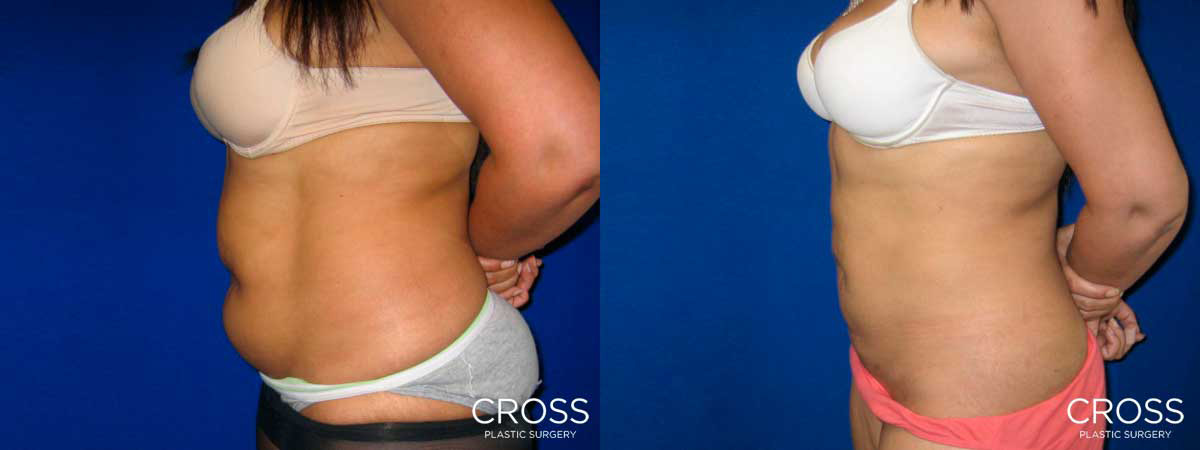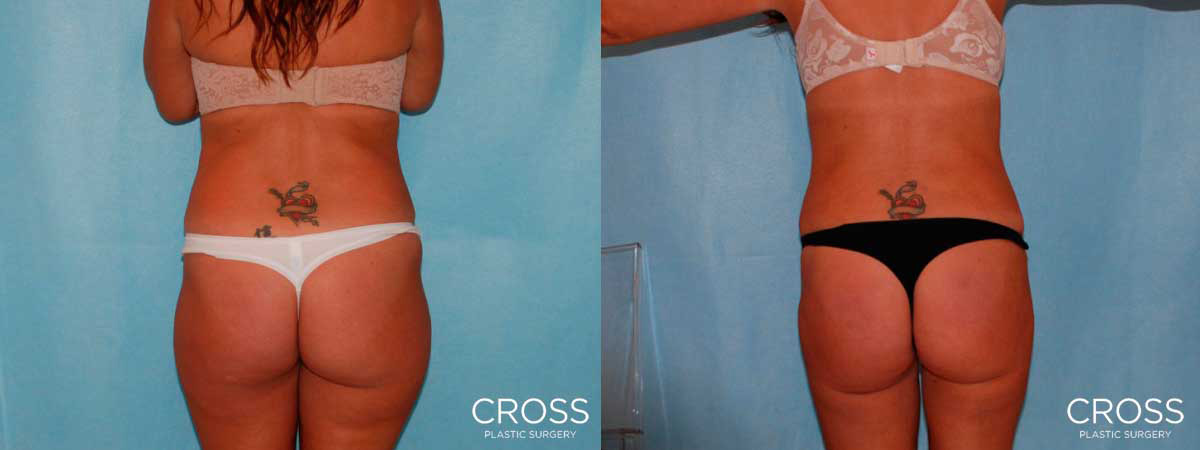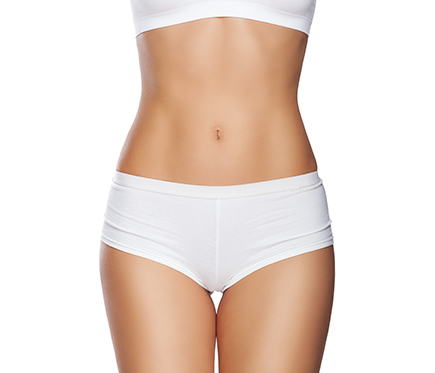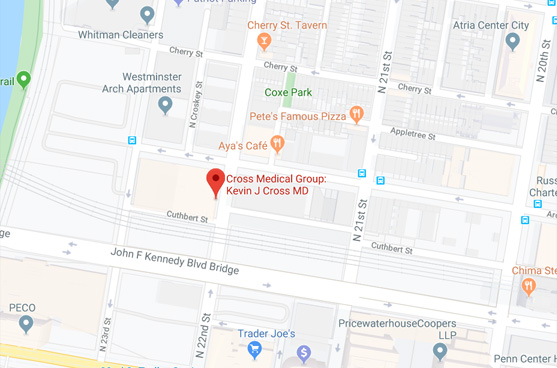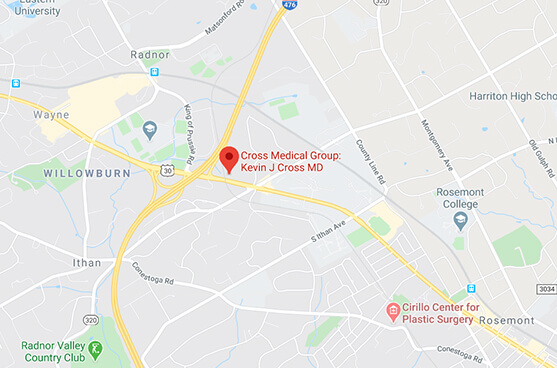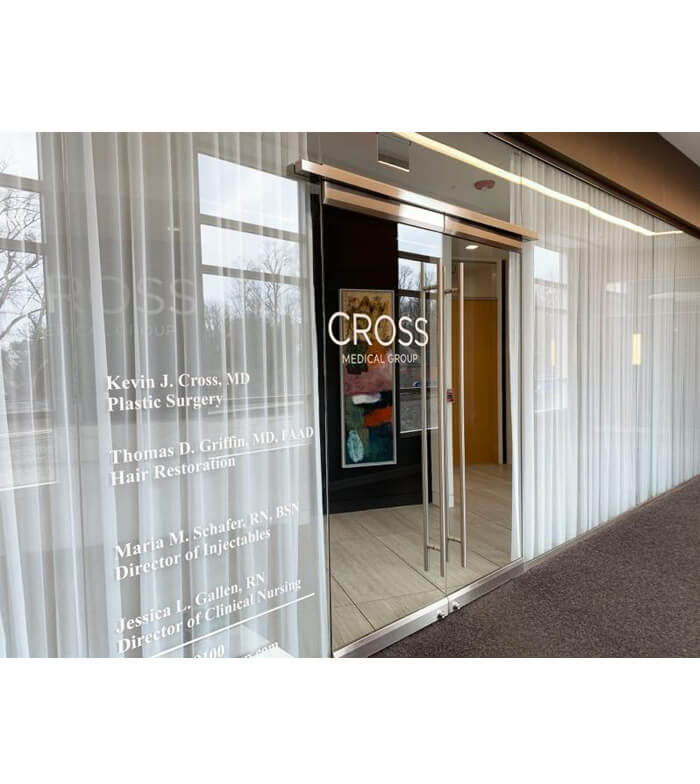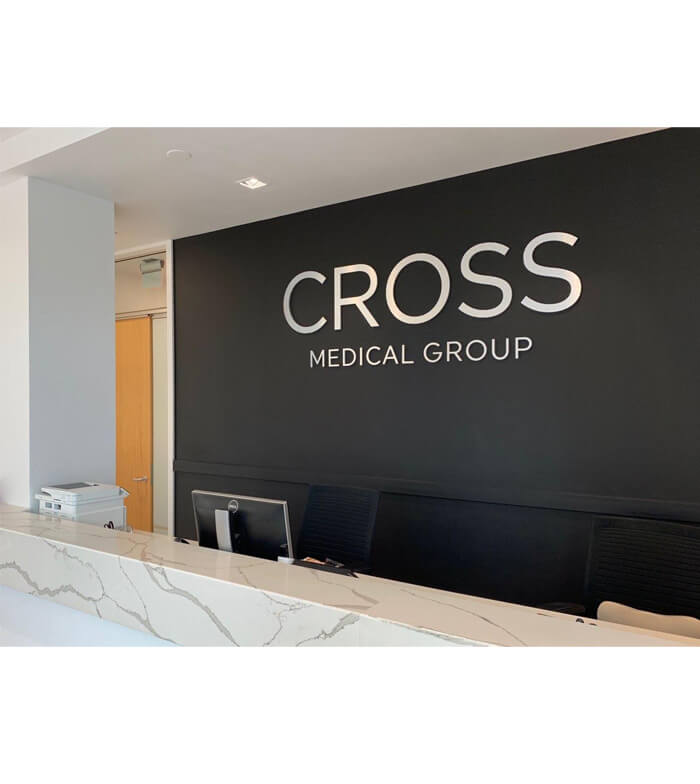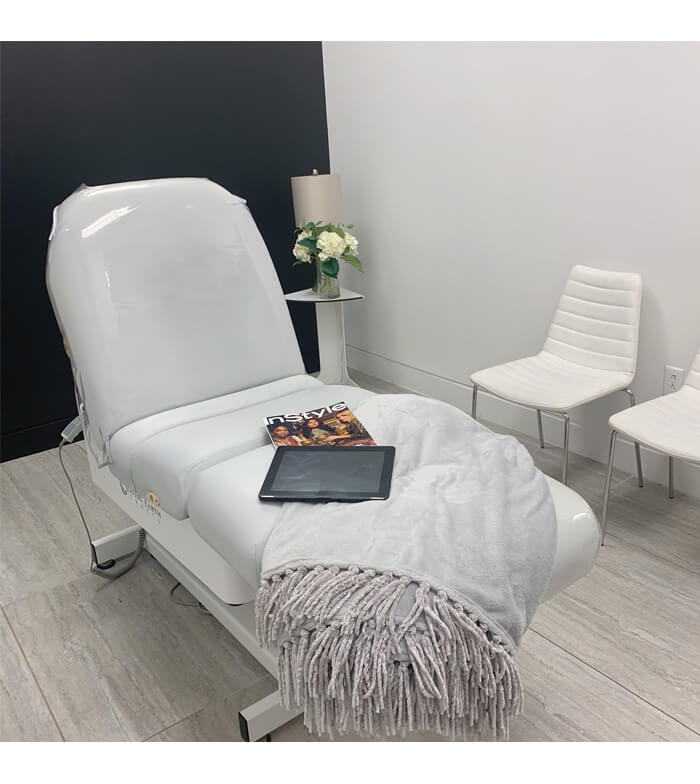Liposuction
BODY CONTOURING TO REDUCE AND RESHAPE TARGETED AREAS
Liposuction at the Philadelphia area's Cross Medical Group is a cosmetic surgery procedure that allows for the removal of unwanted fat from specific areas of the body. Reducing stubborn volume—from excess belly fat to “padding” on the flank or thighs to a double chin—shapes those areas and proportions via a process known as body contouring.
Rather than focusing on fat cells’ size—which is all that diet and exercise can do—liposuction targets the actual number of fat cells in a given area. Since fat cells get bigger when you gain weight and smaller when you lose it, physically reducing their numbers allows for more precise and long-lasting results. Our team works with a diverse group of patients seeking body contouring and can explain more about how you could benefit from liposuction.
WHAT IS LIPOSUCTION?
Why do patients so frequently choose liposuction? What is the main benefit of liposuction? Why do people get liposuction instead of losing weight? These are some of the top questions people ask about this cosmetic procedure.
First, it is important to emphasize that liposuction is a cosmetic procedure, not a weight-loss strategy. The surgery is ideal for shaping body contours, but a sensible diet and consistent exercise are still paramount when it comes to overall shedding pounds, as well as maintaining good health.
With this in mind, as Dr. Kevin Cross has written in a liposuction textbook chapter on the surgical fat-reduction option: "Liposuction is the most commonly performed surgical procedure in cosmetic Medical Group, and for good reason." Liposuction is expected to remain popular, mainly because it is such an effective and reliable option.
So how does liposuction work?
First, the basics: This is cosmetic procedure involves resistant fat being suctioned out of small areas where deposits have the tendency to accumulate.
Performed correctly, liposuction can be a very effective shaping tool. As a contouring strategy, liposuction can be used all over the body. It can treat the abdomen, ankles, arms, buttocks, cheeks, chin, hips, knees, neck, thighs, upper arms, and waist. By removing small amounts of fat, different areas of the body are not just “reduced,” but can be sculpted for natural-looking contours.
Fat is physically dislodged and then removed from beneath the skin via a specialized tool inserted into the targeted area. There are also dozens of liposuction variations, including traditional liposuction, which involves manually freeing fat cells for removal, and liposuction that uses ultrasonic or laser energy to loosen the fat.
More important than the technique, however, is the surgeon performing the technique. Specific forms of liposuction are more appropriate in certain situations, but for most patients, the surgeon performing the procedure is the most important factor. Choose a board-certified plastic surgeon with significant experience in bodycontouring procedures.
SCHEDULE A CONSULTATION
Ready to learn more about the benefits of liposuction in the Philadelphia area? Contact Cross Medical Group to request a consultation with Dr. Kevin Cross or Dr. Jackie Lyons. Call (215) 561-9100 (Philadelphia) or (610) 688-9100 (Villanova), or send a message online.
WHO SHOULD GET LIPOSUCTION?
“Who are the best candidates for liposuction?” “Who is best suited for liposuction?” If you’re planning on having this surgery, these are two of the main questions you might have on your mind.
Liposuction is considered ideal for patients who are within 30 percent of their ideal weight, who are non-smokers, who have firm and elastic skin, and who maintain a positive attitude and realistic expectations about the procedure.
It is not a treatment for being overweight or obese and won't substantially improve the look of cellulite. If you have health problems such as heart disease, diabetes, or a weak immune system, you may be advised to make a different choice.
Although excess fat can make cellulite seem more pronounced, volume or bulk is not the main cause of the unwanted dimpling. Keep in mind that liposuction is not a recommended treatment for cellulite—and can actually make the condition look worse because it can take some volume away from the skin. If cellulite is a particular concern, talk to the Cross Medical Group team about treatment strategies that can focus on the “orange peel” texture either on their own or in combination with other treatments and procedures, such as liposuction.
Since liposuction is intended for fat removal, patients who want to tighten lax skin due to aging or pregnancy should consider a procedure or treatment that focuses on addressing sagging. Lifts and tucks accomplish this and are often paired with liposuction for comprehensive body contouring results. Patients who have good skin elasticity are likely to have excellent results from liposuction, as their skin will more readily tighten and sit flatter over the newly reduced area, showing the slimmer and sleeker contours.
LIPOSUCTION VS. WEIGHT LOSS: HOW MUCH WEIGHT CAN YOU LOSE WITH LIPOSUCTION?
Many patients would like to alter their physique by reducing resistant fat from certain areas. As noted above, patients should be aware that liposuction is not designed to be a treatment for obesity nor a substitute for a healthy diet and regular exercise. One of the biggest misconceptions about liposuction is that it helps you lose a lot of weight. In reality, the majority of patients will only lose two to five pounds on average. You don’t have to be overweight to have liposuction. In fact, ideal candidates will be within 30 percent of their healthy weight range, but have some isolated, problematic fat pockets they would like to treat.
LIPOSUCTION FACTS: WHAT ARE “PROBLEM AREAS?”
You might be wondering, “Can liposuction improve problem areas?” To understand how this form of surgery works, you first need to be aware of how body fat works and why stubborn “problem areas” develop. Unfortunately, the fat on our body won’t always be distributed the way we would like it to be—and even after we successfully lose weight through lifestyle changes or even medical interventions, we may not lose it from the areas where we want to reduce it. Everyone carries fat differently, and most of us have some problem areas where stubborn fat has the tendency to linger, whether it's the thighs, flanks, belly, upper arms, or all of the above. Liposuction allows our plastic surgeons to specifically address patients' “troublesome” areas or “problem areas” and create naturallooking contours.
It is important to understand that each fat cell is like a tiny balloon filled with a small amount of fat. Studies have shown that we have a generally set number of fat cells in the body that remains constant throughout adulthood. Fat cells don't go anywhere when we lose weight through traditional methods. They simply shrink or grow larger. When many of these cells congregate in one area and swell to a large size, they can be difficult to shrink back down again— even with diet and exercise.
The result can be a stubborn bulge, such as the pocket of fat that causes a double chin, or more significant bulk, such as excess volume on the belly and flanks.
Since the number of fat cells stays the same regardless of how much your weight fluctuates, it can be difficult to lose weight and keep it off. This is why so many patients turn to cosmetic surgery as a way of removing the resistant fat cells from specific body areas. Liposuction enhances the shape of these areas with results that are visible right away and get rid of the unwanted fat for good.
CAN LIPOSUCTION REMOVE ANY TYPE OF FAT?
The fat most commonly addressed with liposuction is known as subcutaneous fat, lying just under the skin. This is the soft, wobbly, pinchable fat that can be seen and felt. This fat's thickness varies in different regions of the body.
Running through the fat are bands of ligaments, called septae, which originate near the muscles under the fat and connect to the overlying skin. The relationship between the thickness of the fat and the density of the bands determines how safely an area can be treated without resulting in irregularities like waviness and depressions.
Your plastic surgeon will assess any area where fat reduction is desired and determine the best technique for achieving ideal results.
One of the questions the Cross Medical Group team sometimes gets asked is, “Can liposuction remove visceral fat?” Liposuction and other types of Medical Group cannot remove visceral fat, which is the deep, hard abdominal fat that surrounds the internal organs and creates a protruding belly. Visceral fat can only be reduced through exercise and other healthy lifestyle choices.
Some patients find that seeing their new body contours after this surgery inspires them to make lifestyle changes that improve their health. This creates a positive feedback loop: As patients feel better, they grow in confidence and motivation to make more beneficial changes that shape and tone their body contours.
SCHEDULE A CONSULTATION
Would you like to discover more about liposuction in the Philadelphia area? Contact Cross Medical Group to request a consultation. with Dr. Kevin Cross or Dr. Jackie Lyons. Call (215) 561-9100 (Philadelphia) or (610) 688-9100 (Villanova), or send a message online.
HOW DO YOU PREPARE FOR LIPOSUCTION?
How do you prepare your body before liposuction? What should you not do before liposuction? Before your surgery, we will discuss what you can expect, review your medical history, and ask about any medical conditions you might have. Tell us about any medications or supplements you are taking. We recommend that you avoid taking certain types of medicines, like blood thinners, if it is medically safe for you to do so. This reduces the risk of certain side effects, such as significant bruising.
WHAT HAPPENS DURING THE LIPOSUCTION PROCEDURE?
Nearly all forms of liposuction at Cross Medical Group start with an identical first step: Your plastic surgeon will infuse the targeted tissue with a solution that helps to numb it, as well as reduce bleeding and bruising. This solution is delivered through a long, thin instrument, just thicker than a needle.
Next, the fat must be freed for removal. Historically, plastic surgeons would move a hollow tube called a cannula back and forth to release fat cells from their surrounding tissues. The freed fat would then be suctioned out through the cannula, which performed double duty as a vacuum tool. Cross Medical Group now uses a three-step process for fat reduction, which involves freeing the fat before removal to allow suctioning to occur in a gentler and more precise fashion. The remaining tissues are then blended to help ensure a smooth end result.
This three-step process involves what is known as a power-assisted liposuction (PAL) system. Vibratory mechanics loosen the fat cells, leaving blood vessels, nerves, and other important structures intact during the process. This limits trauma—and thus reduces bruising and discomfort during recovery. These freed fat cells are then removed using less suction power than is typically used for liposuction, further reducing tissue injury and recovery time. The remaining fat cells under the skin are then blended in the third step to avoid lumpiness and contour irregularities.
The entire procedure is performed using incisions that are smaller than the diameter of a pinky nail.
Other advances in technology allow for the application of energy, such as ultrasound or laser, to break up the fat cells, but these techniques tend to be over-used by doctors. This is why the Cross Medical Group plastic surgeons feel that these techniques should be used only in certain situations, because, in most cases, they increase risk of complications—including fluid collections and burns of the underside of the skin—without adding benefit to the end result.
HOW LONG DOES IT TAKE TO RECOVER FROM LIPOSUCTION?
How long does it take to heal from liposuction? Since only small incisions are made, recovery is quick for most patients. However, recovery time after this procedure will depend on the area or areas being treated, as well as the amount of fat removed. For instance, patients tend to find that the flanks are sorer than the abdomen, and the thighs sorer than the arms. For most liposuction patients, however, significant soreness—if present at all—is limited to the first few days after their procedure. They are typically able to get back to all of their normal activities within a few days and are able to start exercising in one to two weeks.
All patients wake up after the procedure in a garment to provide support and gentle compression. This garment is similar to a medical version of SPANX and is removed in two days, at which point patients are able to shower and wash their entire body. A second garment is provided at this point, so patients can alternate by washing one while wearing the other. Unlike other practices, Cross Medical Group only has patients wear the garments for one to two weeks at most.
What is the fastest way to recover from liposuction? The type or technique you have and the scope of the surgery—as in, whether you only had one or two areas treated or had fat removed from all over your body—will also affect how long and involved your recovery will be. Although each person’s recovery experience is unique, it is common to experience bruising, swelling, and firmness for several weeks. Wearing the compression garment will help to provide relief for these side effects. Adopting an anti-inflammatory diet a few weeks ahead of the surgery and continuing it after the surgery can help to improve how your body heals. Give your body time to fully rest and recover. Don’t hesitate to ask questions if you’re unsure about some aspect of your recovery.
WHEN WILL I SEE RESULTS FROM LIPOSUCTION?
You’re probably wondering, “How soon do you see results from liposuction?” or “How long after lipo do you see final results?” Patients often see improvement over their pre-treatment appearance within a week or two, but final results are not seen for a few months. You can expect some changes in your body shape as the remaining fat settles into position. Your new, sculpted body contours from the surgery will be visible once the swelling and fluid retention subside. It can take months for the swelling to go down and final results to show.
*Results May Vary
Before & After Photo Gallery
See for yourself the patient transformations that can be achieved by Dr. Cross, Dr. Lyons, and their team.
WILL THE FAT RETURN AFTER LIPOSUCTION?
The Cross Medical Group team commonly gets asked whether removing fat from one area with liposuction can cause the fat to grow back in other areas. This is a question that patients have been asking Dr. Kevin Cross and Dr. Jackie Lyons since they performing liposuction, and they still ask it. Fat will not spontaneously show up in another part of the body if it has been removed from a different location. What can happen, however, is that fat can increase in other locations if a patient gains weight.
If weight gain used to mean that fat increased in an area, and that area is then treated with liposuction, the same weight will not easily be able to accumulate where it used to go. In that case, it may preferentially go to other areas, but this occurrence is rare. As the body ages, it may lose some of its firmness but the results from this procedure should remain.
HOW DO YOU PRESERVE OPTIMAL RESULTS FROM LIPOSUCTION?
To get the best results from this surgery in the long-term, it's recommended that you maintain a stable weight. Patients are typically encouraged to achieve their ideal body weight—or at least get close to it—and then stay at that weight for at least several months in order to ensure they are stable before choosing liposuction surgery.
WHICH COSMETIC PROCEDURES COMPLEMENT LIPOSUCTION?
Liposuction is ideal for removing excess volume, but a different body surgery approach is needed to address stretched-out skin due to aging, weight fluctuations, or pregnancy. A tummy tuck will remove sagging tissue left behind after significant weight loss or pregnancy, as well as repair separated muscles. Excess skin can also be removed via arm lift, thigh lift, buttock lift, lower body lift, face lift, and neck lift. Other body contouring procedures such as tummy tuck surgery can be combined with liposuction to maximize results. Surgical fat removal is also typically a key component of Mommy Makeover procedures, which seek to restore pre-baby contours for patients who have gone through pregnancy and childbirth.
WHAT IS FAT TRANSFER WITH LIPOSUCTION?
Fat transfer—also referred to as autologous fat transfer, fat injections, or fat grafting—involves using liposuction to extract fat cells from one location and move them to another. This strategy can add fullness to areas where volume has been depleted due to aging or injury. For example, fat transfer is often used in breast augmentation as a substitute for implants to add subtle fullness.
ARE THERE NON-SURGICAL FAT REDUCTION, SKIN TIGHTENING, OR BODY CONTOURING OPTIONS?
What is the best non-surgical fat removal procedure? What is the most effective alternative to liposuction? Can I remove fat without surgery? Individuals who are seeking alternatives to cosmetic surgery may benefit from non-surgical aesthetic treatments.
Patients with a double chin may choose Kybella® for fat reduction. This injectable uses deoxycholic acid to break down fat cells in the submental area to sculpt a slimmer jawline area. The fat is metabolized by the body and can't return. No surgery is involved, but results are more gradual and less dramatic than possible with liposuction. SculpSure® is a non-surgical treatment that treats stubborn fat and enhances the contours of your body. This can be a highly effective alternative to liposuction for patients who want to have resistant fat removed from their waist or flanks.
In places where septae pull the surface skin down into dimpled areas of cellulite, Cellfina® can sever the connective bands for a smoother look. Remember that cellulite is not caused by fat, but removing fat via liposuction can help to relieve a bit of the tension that makes unwanted dimpling form.
SCHEDULE A CONSULTATION
Contact Cross Medical Group if you would like more information about liposuction in the Philadelphia area. Call (215) 561-9100 (Philadelphia) or Main Line's Villanova (610) 688-9100. You can also send a message online to inquire about a consultation, with Dr. Kevin Cross or Dr. Jackie Lyons, or for more information.


